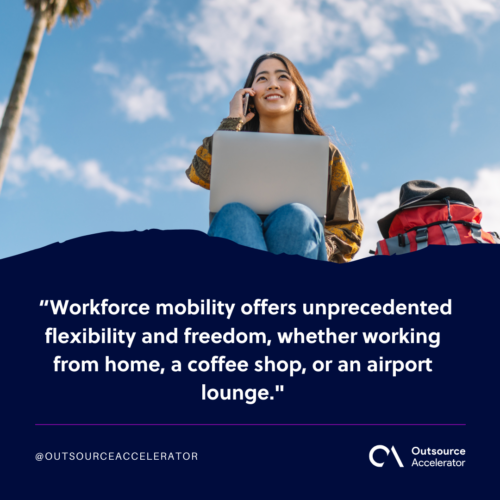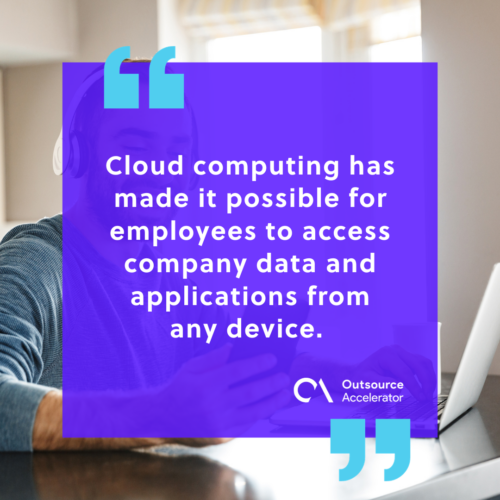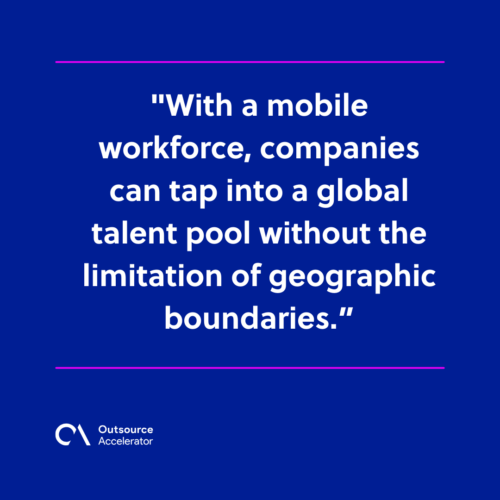How workforce mobility changes businesses

Workforce mobility is a term that has gained significant attention in recent years.
This concept has become increasingly important as businesses seek to adapt and thrive in a rapidly changing world.
In this article, we will explore what it is and how it changes the way businesses work.
What is workforce mobility?
Workforce mobility refers to the ability of employees to work from anywhere, anytime, using any device.
Gone are the days when employees were tied to their desks, limited by physical boundaries. With advanced technology and connectivity, employees can now collaborate, communicate, and complete tasks from remote locations.
It’s how firms like Booth and Partners are able to maximize their talents’ capabilities to serve clients offshore.
Workforce mobility offers unprecedented flexibility and freedom, whether working from home, a coffee shop, or an airport lounge.

Importance of workforce mobility
Workforce mobility is a great way for firms to cut operating costs while helping the economy save. Global Workplace Analytics’ telework savings calculator estimates that in the US alone, the economic benefits of telework can reach as much as US$700 billion a year.
Businesses that embrace workforce mobility gain a competitive advantage in attracting and retaining top talent.
Primarily, this work arrangement flexibility increases productivity and efficiency. Employees can focus more on their tasks by eliminating the need for commuting and reducing distractions often found in traditional office settings.
Furthermore, workforce mobility enhances employee well-being. It reduces stress and time associated with commuting, allowing employees to achieve a healthier work-life balance.
This, in turn, leads to increased job satisfaction and improved overall employee morale.
How workforce mobility is changing
Workforce mobility is not static; it is evolving along with technological advancements and changing attitudes toward work.
Here are some notable ways in which employee mobility is changing:
Virtual collaboration tools
Advanced virtual collaboration tools have revolutionized the way teams work together. It allows them to effortlessly communicate, share files, and collaborate on projects in real time.
Cloud computing
Cloud computing has made it possible for employees to access company data and applications from any device. This means employees can work on the go without being tied to a specific device or location.

Flexible work schedules
Many companies embrace flexible work schedules, allowing employees to choose when they work best. Teams can have the freedom to structure their workday around their personal preferences and priorities.
Remote work policies
The pandemic has accelerated the adoption of remote work policies. Companies that were once hesitant to embrace remote work have been forced to adapt, and many have realized the benefits and productivity gains it offers.
Best practices for workforce mobility
To maximize the benefits of workforce mobility, businesses should consider implementing the following best practices:
Investing in reliable technology
Businesses must invest in reliable technology infrastructure to ensure seamless collaboration and protection of information.
This includes providing employees high-speed internet access, secure VPN connections, and up-to-date devices and software.
At the same time, routine cybersecurity checks are necessary to maintain the utmost security in their functions.
Establishing clear expectations
Employees should have a clear understanding of their roles, responsibilities, and performance metrics when working remotely.
Regular communication and feedback channels should also be established to maintain accountability and productivity.
Promoting work-life balance
Flexible work arrangements should be accompanied by a focus on work-life balance. Encouraging employees to take breaks, set boundaries, and prioritize self-care helps prevent burnout and fosters a healthier, more productive workforce.
Creating a remote-friendly culture
Building a remote-friendly culture entails creating opportunities for virtual social interactions. This fosters a sense of belonging and recognizing remote employees’ contributions.
Employers must make sure that remote employees have equal access to professional development, networking opportunities, and career advancement.
Ensuring data security
With the increase in remote work, data security becomes paramount.
Companies must adopt strong security measures to safeguard confidential information. This includes using secure network connections, enforcing strong password policies, and educating employees on best practices for data protection.
Leveraging workforce mobility
Leveraging workforce mobility opens up new possibilities for businesses.
With a mobile workforce, companies can tap into a global talent pool without the limitation of geographic boundaries. This allows for diverse perspectives, innovative ideas, and increased global reach.

Employee mobility enables businesses to adapt quickly to changing market demands. Firms can respond swiftly to market trends and industry disruptions with the ability to scale up or down the workforce as needed.
Moreover, workforce mobility has a positive impact on the environment. Businesses can contribute to a decrease in carbon emissions and alleviate traffic congestion by reducing the need for commuting.
Companies can also save costs through this setup. With a reduced need for physical office space, They can cut down on rent, utilities, and maintenance expenses.
Workforce mobility is transforming the way businesses operate. With this setup, employers can attract top talent, increase productivity, enhance employee well-being, reduce environmental impact, and save costs.







 Independent
Independent




